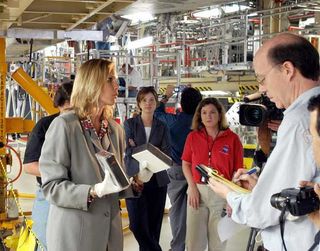Discovery Makes Headway Toward March Launch

Efforts to ready the space shuttle Discovery for flight are gathering steam as NASA engineers passed key milestones for both the spacecraft and its rocket boosters.
Sitting in its hangar at NASA's Kennedy Space Center in Florida, Discovery has successfully been powered up by ground crews after more than 100 modifications to its systems and a series of upgrades specifically aimed at the agency's planned return to flight for the aging fleet.
Discovery vehicle manager Stephanie Stilson said she is "very optimistic" that the spacecraft is moving toward a launch next spring. Discovery is set to be the first shuttle to fly since the loss of Columbia in February 2003. Discovery, as part of the STS-114 mission, is expected to launch no earlier than March 6, 2005.
In addition to normal maintenance and enhancements, such as the installation of a "glass cockpit," shuttle engineers have equipped Discovery with electrical wiring and cables for 176 new sensors - 88 per wing - to measure acceleration, impact and temperature changes during launch. Wiring has also been laid for an external tank-watching digital camera and an anticipated boom that could be used to survey the shuttle's exterior for damage.
Engineers have also delivered the first segment for one of the shuttle's two solid rocket boosters (SRBs) on Aug. 9.
The segment, a skirt-shaped piece that forms the base of the rocket, was moved to a facility at the center where technicians will install an aft motor segment and ring fitting that will attach the rocket to Discovery's external tank.
"Piece by piece, milestone by milestone, we're getting closer to flying the shuttle again," said Michael Kostelnik, deputy associate administrator for International Space Station (ISS) and space shuttle programs, in a written statement.
Get the Space.com Newsletter
Breaking space news, the latest updates on rocket launches, skywatching events and more!
Engine tests
While shuttle engineers toil away on Discovery's body, a team of propulsion specialists have completed testing on the last of three engines the spacecraft will use to reach orbit.
Engineers fired the engine for 520 seconds -- the flight time required to carry Discovery from launch to space - during a nighttime Aug. 19 test.
Miguel Rodriguez, NASA's director of the propulsion directorate at Stennis Space Center in Mississippi, told SPACE.com that engine will be shipped to KSC by early September for integration.
The first main engine has already been sent to Discovery, while a second is still awaiting shipment. Along with STS-114's engines, SSC engineers are also delivering three additional engines as part of normal redundancy procedures.
"It's one less thing to worry about for the [shuttle] engineers, so they can put all their effort into other areas," Rodriguez said. "All of us together, as a team, are very excited about it."
Join our Space Forums to keep talking space on the latest missions, night sky and more! And if you have a news tip, correction or comment, let us know at: community@space.com.

Tariq is the Editor-in-Chief of Space.com and joined the team in 2001, first as an intern and staff writer, and later as an editor. He covers human spaceflight, exploration and space science, as well as skywatching and entertainment. He became Space.com's Managing Editor in 2009 and Editor-in-Chief in 2019. Before joining Space.com, Tariq was a staff reporter for The Los Angeles Times covering education and city beats in La Habra, Fullerton and Huntington Beach. In October 2022, Tariq received the Harry Kolcum Award for excellence in space reporting from the National Space Club Florida Committee. He is also an Eagle Scout (yes, he has the Space Exploration merit badge) and went to Space Camp four times as a kid and a fifth time as an adult. He has journalism degrees from the University of Southern California and New York University. You can find Tariq at Space.com and as the co-host to the This Week In Space podcast with space historian Rod Pyle on the TWiT network. To see his latest project, you can follow Tariq on Twitter @tariqjmalik.
